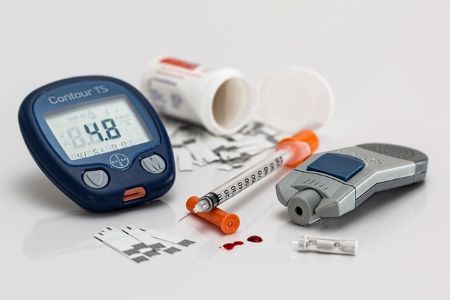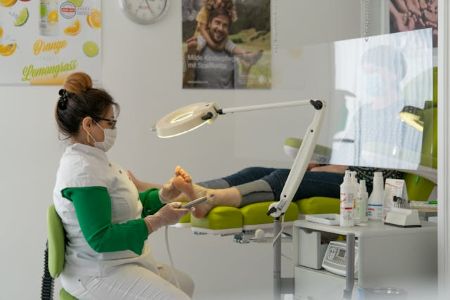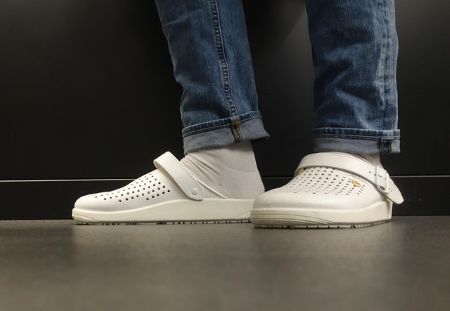Introduction
According to the International Working Group on the Diabetic Foot, one person undergoes a lower limb amputation every twenty seconds worldwide due to complications from diabetes1.

Diabetes Mellitus is a chronic metabolic condition originating in the pancreas, characterised by decreased insulin production and higher levels of blood glucose. These pathophysiological changes can create an environment for increased build-up of arterial plaque causing hardened (arteriosclerosis), narrowed blood vessel walls (atherosclerosis) and longer durations of inflammation contributing to impaired healing. According to the American Diabetes Association, 85% of lower limb amputations are preceded by a Diabetes-related Foot Ulcer2.
Diabetes-related foot complications such as peripheral neuropathy and peripheral arterial disease can arise from unregulated blood glucose management. Lifestyle factors such as alcoholism and smoking can contribute significantly to the development of these conditions. Peripheral Neuropathy is a loss of protective sensation in the feet due to nerve damage from increased blood glucose levels. According to the National Institute for Health and Care Excellence, Peripheral Arterial Disease (PAD) is a loss of blood flow to the lower extremities due to arteriosclerosis and atherosclerosis3. The most common symptom of PAD is intense cramp-like sensations in the legs and feet while exercising which are relieved by rest.

This is called intermittent claudication. In more severe cases, such as in Chronic Limb-threatening Ischaemia, burning sensations may be experienced by individuals with arterial obstructions. Diabetes-related foot complications such as Foot Ulcers (DFUs) are often associated with peripheral neuropathy and PAD.
Prevention
With the International Diabetes Federation forecasting 850 million individuals developing type 2 Diabetes Mellitus by 2050, there are three main concepts that are foundational to a preventative approach in foot health going forward.
Assessment. Treatment. Education4.
Assessment. A Podiatrist is an essential part of foot and lower limb assessment for individuals with diabetes as detection of peripheral neuropathy and PAD can be escalated to the patient’s GP for further assessment. When an ulcer is determined by a Podiatrist, the consideration of peripheral neuropathy and PAD is integral to classifying the risk-status of the individual5.

Treatment. Pre-ulcerative lesions such as Corns and Callus can be key dermatological indicators of pressure on the plantar surface of the feet. These conditions can often precede the occurrence of DFUs and impact quality of life and standard of living. Therefore, timely referrals to Podiatrists for treatment of pre-ulcerative lesions is crucial in reducing the risk of foot ulceration6. Treatments may include scalpel debridement, offloading orthotic devices and urea-based emollients. Continuity of treatment for perpetuating conditions such as callus build up on heels can reduce abnormal plantar pressures and maintain skin integrity.
Education. Patient support groups, conferences and psychotherapy are examples of information sources which can develop knowledge in the community and for individuals to address barriers to change or adherence to elements of a healthcare plan such as glucose monitoring or footwear recommendations. This is especially important for patients with diabetes as non-adherence can lead to abnormal pressure exertion on the feet from unsuitable hosiery, footwear and structural deformity (i.e. hammer toes, hallux valgus). Providing an environment for individuals with diabetes to communicate the challenges they face (i.e. sleep apnoea), receive new knowledge and practical advice is integral to preventing DFUs7.
Summary
Diabetes-related foot complications such as peripheral neuropathy and PAD are key determinants of the high-risk foot in diabetes which may increase the likelihood of diabetes-related foot ulcers, recurrent ulceration and lower limb amputation. The severity and impact on quality of life is essential to informing patients of preventative strategies to reduce the extent of mechanical forces and protect vulnerable tissue on bony prominences (i.e. hammer toes, hallux valgus).

Hosiery, footwear, low-intense activities, diet, quality of sleep and habitual blood-glucose monitoring are key building blocks for individuals with diabetes to implement in daily life which improves the environment for preventative foot health awareness.
References
- International Working Group on the Diabetic Foot.
- Chamberlain RC, Fleetwood K, Wild SH, et al.. Foot Ulcer and Risk of Lower Limb Amputation or Death in People With Diabetes: A National Population-Based Retrospective Cohort Study. Diabetes Care. 2022;45(1):83-91. doi:10.2337/dc21-1596
- National Institute for Health and Care Excellence (NICE). Lower Limb Peripheral Arterial Disease. Information for the Public Leaflet. 2012. Page 3.
- International Diabetes Federation. Facts and Figures. [Accessed 3/07/2025]
- Brocklehurst JD. The Validity and Reliability of the SINBAD Classification System for Diabetic Foot Ulcers. Adv Skin Wound Care. 2023 Nov 1;36(11):1-5. doi: 10.1097/ASW.0000000000000050.
- Hashmi F, Nester CJ, Wright CRF, Lam S. The evaluation of three treatments for plantar callus: a three-armed randomised, comparative trial using biophysical outcome measures. Trials. 2016;17(1). doi:10.1186/s13063-016-1377-2
- Goodall RJ, Ellauzi J, Tan MKH, Onida S, Davies AH, Shalhoub J. A Systematic Review of the Impact of Foot Care Education on Self Efficacy and Self Care in Patients With Diabetes. European Journal of Vascular and Endovascular Surgery. 2020;60(2):282-292. doi:10.1016/j.ejvs.2020.03.053
Main – Photo by Rune Enstad on Unsplash





